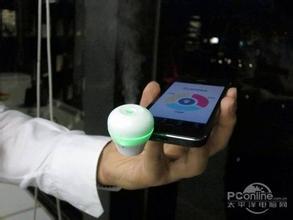
We can express thoughts and feelings and send sounds and pictures on our smartphones today. We can’t send tastes, smells or touch, of course. But scientists in Britain are trying to develop a way for smartphones to do just that.
Adrian David Cheok is a professor at City University in London. He wants people to experience communication using all of their senses. “In the real world, we can open up the glass, open the window. We can touch, we can taste, we can smell in the real world.”
To give users a sense of taste, researchers designed two electrodes that are placed on the tongue. A chemical process creates different tastes through molecules on the surface of the tongue. They have already created sour, salty, sweet and bitter tastes. “You put these two silver electrodes in your mouth, you put your tongue in between and then it stimulates electrically your tongue and you get a virtual taste perception in your brain.”
A device called “Scentee” permits users to have the sense of smell. Scentee plugs into a smartphone and can spray tiny clouds of fragrances, including flowers, fruits and coffee. Professor Cheok says the person speaking can activate the device. “Basically what happens, we have an app, it connects to the Internet and then this will release a scent from your mobile phone.” Scentee holds a container with about 100 different smells. The container must be replaced when all the scents run out.
The sense of touch comes from a ring-like device. It is connected wirelessly to the smartphone. The device sends a soft, electrical squeeze when a person on the other end of a telephone conversation does the same. Professor Cheok says this permits a kind of wireless touch communication. “I can be in London and my friend can be in Tokyo, and I can squeeze my finger and then they’ll get a squeeze on their finger through the Internet. It’s a way of touch communication with small mobile devices.”
本时文内容由奇速英语国际教育研究院原创编写,禁止复制和任何商业用途,版权所有,侵权必究!
1.How can one taste with the silver electrodes?
A Your tongue touches the silver electrodes and has a sense of taste.
B The electrodes create different taste through molecules on the surface of the tongue.
C The electrodes produce sour, salty, sweet and bitter tastes for your tongue to taste.
D The silver electrodes stimulate your tongue and you get a taste perception in brain.
解析:选D。D 细节理解题。根据文章第三段的解释可知,将电极置入口中,电极对舌头进行电子刺激,然后人们产生了一种虚拟的味觉。
2.What is the use of “Sentee”?
A It sprays tiny clouds of fragrances of many kinds.
B It releases a scent from your mobile phone.
C It permits users to have the sense of smell.
D It holds a container with about 100 different smells.
解析:选C。C 细节理解题。根据文章第四段首句的A device called “Scentee” permits users to have the sense of smell.可知,本段介绍的是能够让人们产生嗅觉的Scentee,也就是说,Scentee的功能是帮助人们产生嗅觉。A、B两项是Sentee的部分特点,不能概括其所有功能。
3.What can we infer from the passage?
A Future of long-distance communication will be greatly changed.
B One can feel the touch of the other thousands of miles away.
C One can taste or smell when making a conversation on the phone.
D Smell, taste and touch can be sent through a mobile phone.
解析:选A。A 推理判断题。综合文章内容可以判断,信息技术的发展将使手机推送味觉、嗅觉和触觉成为可能,这意味着长途通讯将发生巨大变化。
4.What can be the best title of the passage?
A Devices to Send Senses of Smell, Taste and Touch.
B Smartphones Can Be Used to Sense Taste, Smell and Touch.
C Smartphones Can Do More Than Conversations.
D Senses of Taste, Smell and Touch Via the Internet.
解析:选B。B 主旨大意题。通读全文可知,本文主要介绍了智能手机将来实现味觉、嗅觉和触觉推送的情况,故选B。
5.If you are an editor of a newspaper, which column will you put this article into?
A Health.
B Technology.
C Lifestyle.
D Entertainment.
解析:选B。B 推理判断题。本文介绍了用智能手机实现嗅觉、味觉、触觉推送的技术原理,属于科学技术话题,故选B。